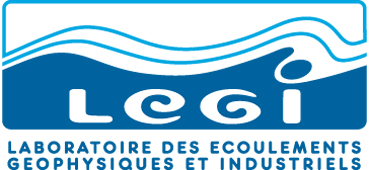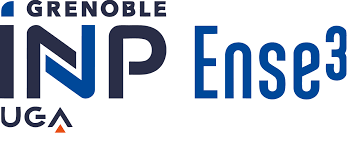Projects
SERDP
In 2019, we have been granted a 1-year proof of concept research contract entitled Novel Eulerian Two-phase Simulations for Burial Dynamics of Munitions funded by the Strategic Environmental Research and Development Program of the United States Department of Defense (SERDP). The success of the first project lead to a new 3 year project funded in 2021.
- Team:
- Tom HSU (PI - Prof., UD, CACR)
- Julien CHAUCHAT (co-PI - associate prof., GINP, LEGI)
- Cyrille BONAMY (research engineer, CNRS, LEGI)
- Eduard PUIG MONTELLA (postdoc, GINP, LEGI)
- Benjamin TSAI (PhD student, UD, CACR)
- Ali SALIMI TARAZOUJ (PhD student, UD, CACR)
This proof-of-concept research effort was led by the objectives to (1) demonstrate that the Eulerian two-phase model SedFoam provides an effective modeling framework to directly resolve critical processes in scour burial, which cannot be achieved by conventional single-phase modeling approach, and (2) implement a few model enhancements toward a more physical-based closure in SedFoam to simulate processes that may lead to deep burial, namely, fluidization and bedforms.
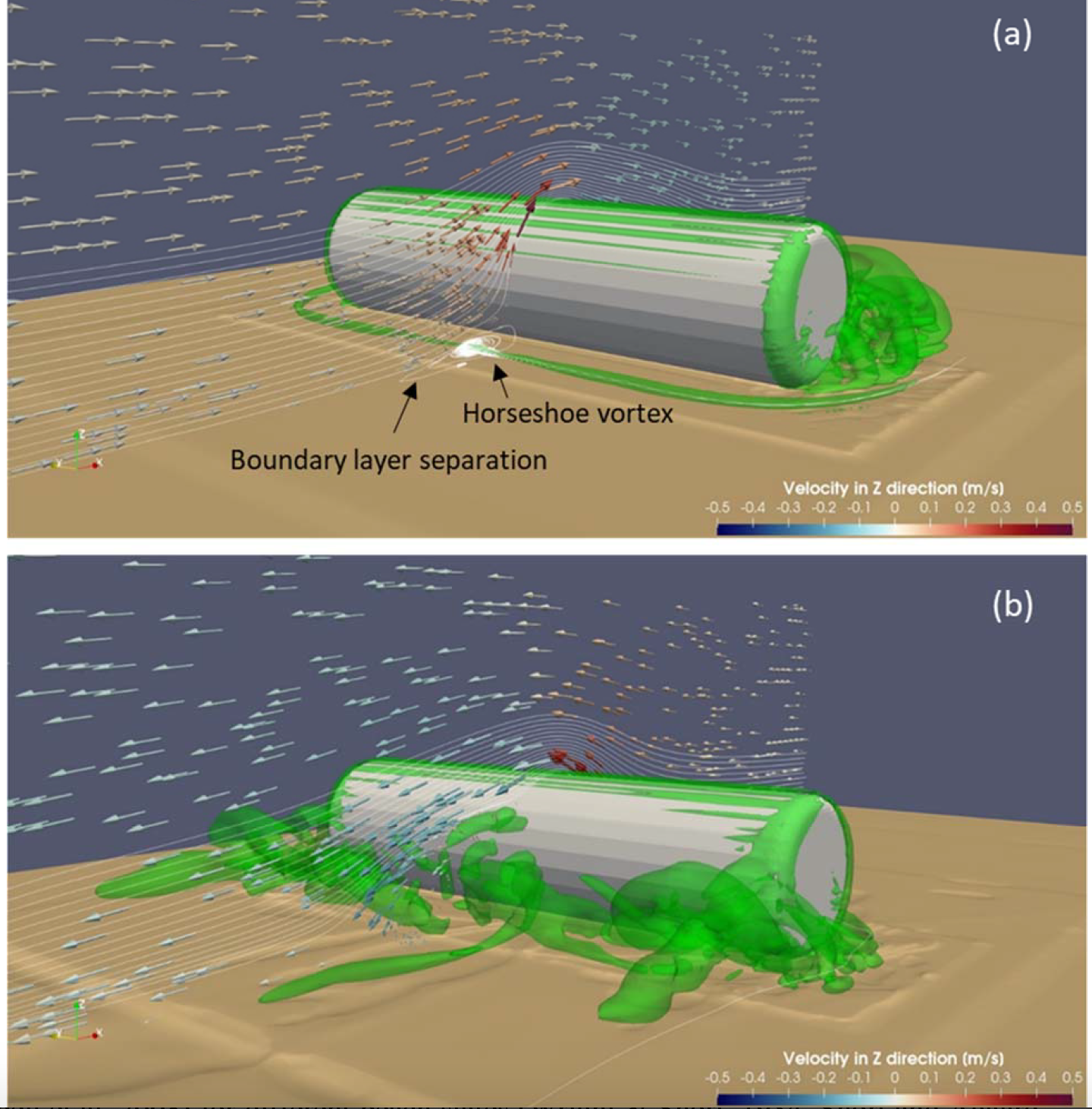
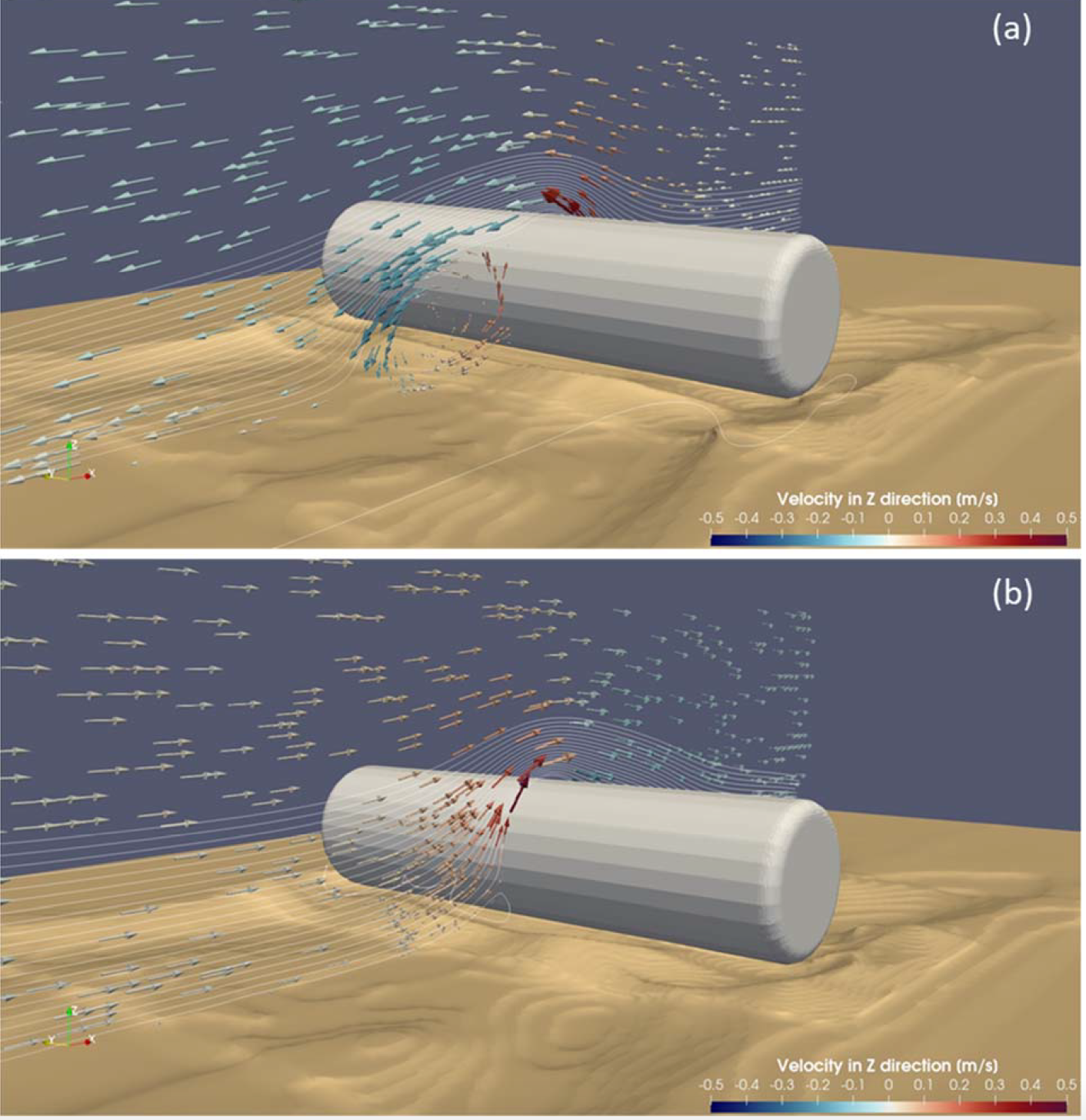
The figure above shows the scour around a 3D short cylinder for medium Keulegan-Carpenter number KC=27.9 at the initial stage (left panels). (a) A snapshot of velocity field, streamlines, coherent structures and bathymetry at wave crest and (b) at the wave trough. The color (see color bar) on the velocity vectors represent the vertical component of the velocity. The coherent structures are identified using iso-surface of normalized vortex vector with magnitude R=15. Right panels show the same configuration after 6 wave period (source: T. Hsu et al., 2020)
ANR SHEET-FLOW
In 2018, I have been granted an ANR JCJC (young researcher) for 4 years to develop new sediment transport experiments, acquire new high-resolution data and develop accurate subgrid models for Eulerian-Eulerian two-phase flow models for sediment transport applications. Please find below a short summary of the project.
- Team:
- Julien CHAUCHAT (PI - associate prof., GINP, LEGI)
- David HURTHER (senior researcher, CNRS, LEGI)
- Guillaume BALARAC (associate prof., GINP, LEGI)
- Cyrille BONAMY (research engineer, CNRS, LEGI)
- Tian-Jian HSU (Prof., University of Delaware, USA)
- Helder GUTA (PhD student, 2019-, LEGI)
- Antoine MATHIEU (PhD student, 2018-, LEGI)
The project SHEET-FLOW develops a two-phase flow approach that potentially incorporates most of the physical processes at stake. It relies on a close synergy between modelling and advanced acoustic instrumentation resolving velocities and concentration at the turbulent scales. This program will be applied to the well-controlled open-channel flows in the 10-m tilting flume facility available at LEGI (Grenoble, France). A wide range of flow conditions and sediment properties will be tested involving lightweight PMMA particles (1 and 3 mm size) and medium and coarse sands. The flow forcing will cover the sheet flow regime or intense bed-load transport corresponding to Shields number in 0.5 to 2. For these conditions, particles inertia is expected to influence sediment fluxes and turbulence damping mechanisms. Another important feature is the role of intermittent sediment bursts on the hydrodynamic roughness. All these processes will be investigated during the project.

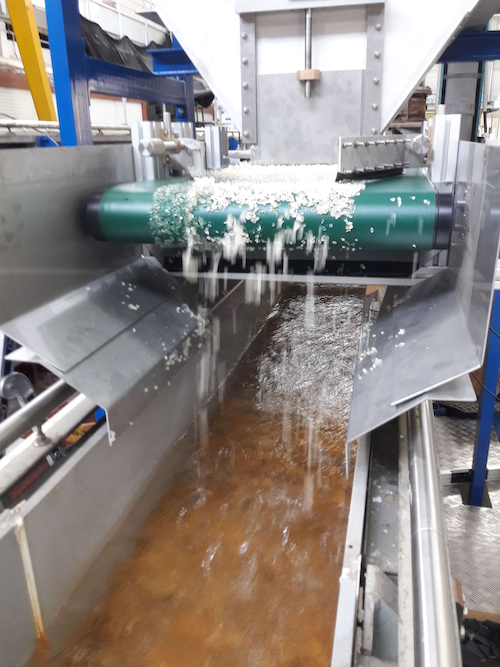

The ultimate goal of the SHEET-FLOW project is to develop accurate Sub-Grid Scale (SGS) models for turbulence resolving two-phase flow simulations or Large Eddy Simulations (LES) of sediment transport in the sheet flow regime. These SGS models encompass fluid-particle forces and fluid and particle phases stress. Different modeling choices will be tested among which the Germano’s decomposition, the gradient diffusion model (istotropic and anisotropic) and the dynamical structure model. A priori analysis of high-reosolution LES simulations will be used to infer the functional dependencies of the sub-grid models on local filtered variables, such as velocity, concentration and their spatial gradients, as well as the grid size. The two-phase LES results will be used to investigate the fine-scale processes leading to turbulence modulation mechanisms, turbulent dispersion of particles and the interplay of intermittent turbulence and inter-granular interaction on the resulting transport dynamics under sheet flow conditions. The methodology will consist in investigating the turbulent kinetic energy budget and the relative contributions of the different stresses to the overall.

The LES results will be used to derive turbulence-averaged parameterizations for two-phase flow models. This last objective is critical to accurately upscale fine-scale turbulence-particle interaction processes in larger scale problems such as dunes evolution during river floods, wave driven sediment transport over sandbars or turbidity currents at the continental margins.
MEPELS Project
In 2018, we have been granted a research contract related to the study of morphodynamic models of the coastal environment, funded by the project MEPELS (Modèle d'Évolution des Plages et Environnements Littoraux Sableux) developed by SHOM (Hydrographic and Oceanographic Service of the Navy).
- Team:
- Julien CHAUCHAT (PI - associate prof., GINP, LEGI)
- Cyrille BONAMY (research engineer, CNRS, LEGI)
- Gaël RICHARD (postdoc, now researcher at INRAE, LEGI)
- Antoine MATHIEU (PhD student, 2018-, LEGI)
- Hassan SHAFIEI (engineer, CNRS, LEGI)
- Philippe LARROUDE (associate prof., UGA, LEGI)
- David HURTHER (senior researcher, CNRS, LEGI)
The research contract consists in the selection and evaluation of the nearshore models to be used in the future MEPELS system as well as to determine their capacities and limitations. The evaluation is performed primarily on the ECORS 2008 field campaign on the Truc Vert beach (mesh sensitivity, input parameter sensitivity, predictive performance). The models that are evaluated are Xbeach, CROCO and Delft3D.
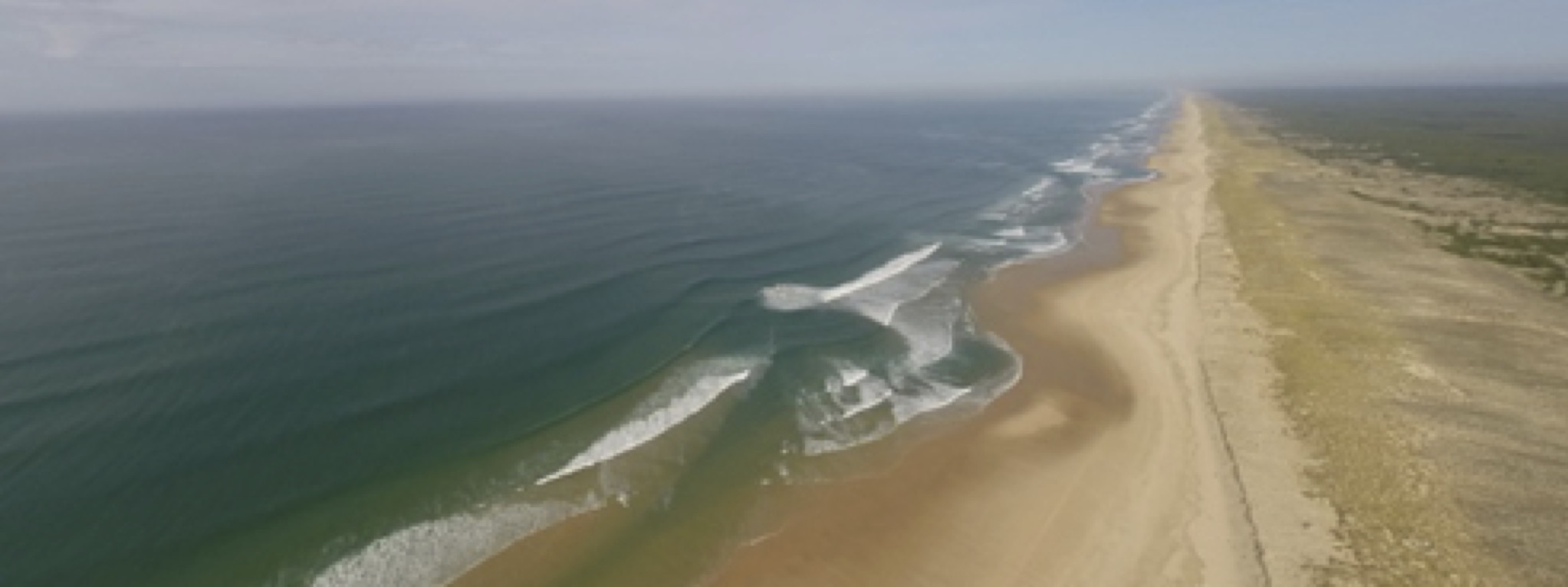
Aerial view of the Truc Vert beach
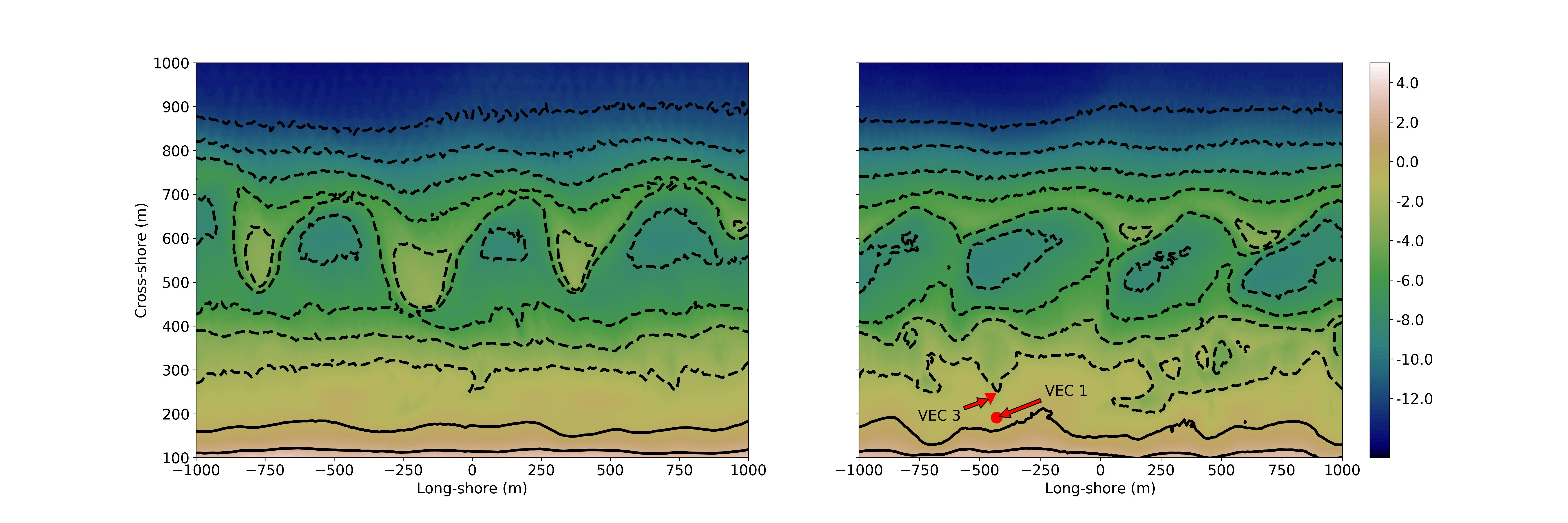
Initial and final bathymeries of the Truc Vert beach during the ECORS'2008 field campaign (Feb. 11 to April 4 2008).
